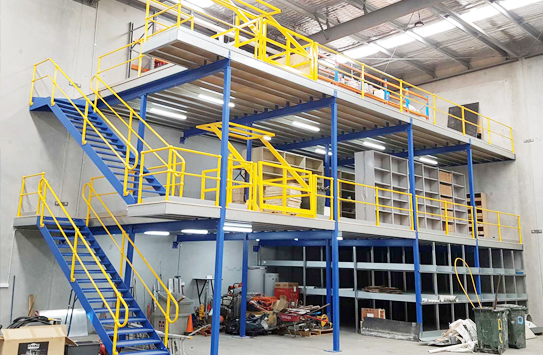Metal Mezzanine are versatile structures used to create additional space in warehouses, factories, offices, and other industrial or commercial spaces. They are a cost-effective solution for increasing storage capacity or providing extra work areas. When it comes to constructing a metal mezzanine, selecting the right materials is crucial to ensure safety, durability, and functionality. In this comprehensive guide, we will delve into the essential materials needed to build a metal mezzanine and discuss their importance in creating a reliable and efficient mezzanine structure.
1. Steel Beams and Columns: The Backbone of a Metal Mezzanine
Steel beams and columns serve as the backbone of any metal mezzanine structure. The choice of steel should be based on load-bearing requirements and design specifications. Commonly used steel types include hot-rolled steel and structural steel, both known for their strength and durability. The quality of steel used is directly related to the overall strength and longevity of the mezzanine.

2. Mezzanine Decking: Crafting a Reliable Walking Surface
The mezzanine decking material is crucial to the mezzanine’s function. Various options are available, including steel grating, metal planks, and plywood. The choice of decking material depends on factors such as the intended use of the mezzanine, weight capacity, and safety requirements.
a. Steel Grating: The Sturdy and Ventilated Option
Steel grating is a popular choice for mezzanine flooring due to its strength and open design, allowing for ventilation and light penetration. Its durability and load-bearing capacity make it an ideal choice for heavy-duty applications.
b. Metal Planks: A Solid Walking Surface
Metal planks are another durable option, typically made from steel or aluminum. They offer a solid walking surface and can support heavy loads. Their durability and versatility make them suitable for various mezzanine applications.
c. Plywood: Cost-Effective for Light Applications
For office or light storage mezzanines, plywood can be used as a cost-effective decking material. It is essential to choose high-quality, industrial-grade plywood for this purpose, ensuring it meets safety and load-bearing requirements.
3. Guardrails and Handrails: Ensuring Safety Above All
Safety is paramount when constructing a metal mezzanine. Guardrails and handrails are essential components to prevent falls and accidents. These are typically made of steel and are designed to meet safety standards and local building codes. Properly installed guardrails and handrails protect workers and visitors using the mezzanine.
4. Staircases or Ladders: Ensuring Access to Your Mezzanine
Access to the mezzanine is essential. Depending on the design and layout of the mezzanine, you will need either staircases or ladders. Staircases are a more convenient choice for areas where frequent access is required, while ladders are suitable for smaller, less frequently accessed mezzanines. Proper access ensures the mezzanine is user-friendly and accessible for all relevant personnel.
5. Fasteners and Connectors: The Glue Holding It All Together
Proper fasteners and connectors are essential to ensure the stability and strength of the mezzanine structure. Bolts, nuts, and anchors should be of high quality and designed to withstand the loads placed on the mezzanine. These components are the glue that holds the entire structure together, and their quality is paramount in ensuring safety and structural integrity.

6. Finishing Materials: Enhancing Functionality and Aesthetics
Depending on the intended use of the mezzanine, you may require finishing materials such as paint, floor coverings, or wall cladding. These materials can improve the aesthetics and functionality of the mezzanine, creating a more pleasant and practical space for its intended purpose. Additionally, a well-finished mezzanine can enhance the overall visual appeal of the space.
7. Fireproofing Materials: Safety in the Face of Fire Hazards
If your mezzanine is used for storage or in an industrial setting, you may need fireproofing materials to meet safety regulations. Fire-resistant coatings or sprays can be applied to steel components to protect against potential fire hazards. Ensuring that the mezzanine is fire-resistant is crucial to safeguard both the structure and the contents it houses.
Conclusion
Building a metal mezzanine involves careful consideration of the materials used to ensure structural integrity, safety, and functionality. Steel beams and columns provide the framework, while decking, guardrails, access methods, fasteners, and finishing materials complete the structure. By selecting the right materials and adhering to safety standards, you can create a durable and versatile metal mezzanine that meets your specific needs. The mezzanine is more than just an elevated space; it’s a solution that maximizes your space and productivity while maintaining the highest standards of safety and quality.
In conclusion, understanding the role of each material in the construction of a metal mezzanine and choosing the right materials tailored to your specific needs is essential to the success of your mezzanine project.




